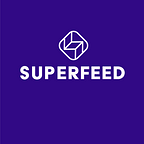We are a sucker for charts. We chart everything, including our love of charts (see Figure 1).
So we thought, why not chart our assumptions of how communities behave? We stress, these are assumptions based on personal observation and experience. If you ask “where’s the data?”, we will look you in the eye, point to our bellies, and proclaim “Our gut.” But while we acknowledge the unscientific nature of the arguments, we hope to provoke serious thinking.
At its core, Superfeed promises to improve community engagement. In order to answer “how likely is a community member to engage?” we need to know two variables: 1. The likelihood that someone wants to engage. 2. the likelihood someone knows how to engage.
Assumption #1: Community members don’t care that much
As we explained in our first post, most community members don’t care that much about communities, even the ones they love. We had a chart in mind and deduced the following formula to make us seem smarter. Ready to be impressed? Here it is:
Desired Engagement Level = 12.5(cos(x)-(x/2)+7)
Here’s why. At first, the community member is super enthused but as memory of their first engagement fades, so too does their desire to be involved. Life just kind of gets in the way. Sure, there’s a quick blip when a community member remembers “Oh shoot! I really should be more involved. I promised I’d be more active this year.” But that guilt is fleeting.
Assumption #2: Only hyper-relevancy is sufficient
Even if a community member wants to engage, she needs to know how; they need to read your communication, be it an email or an app notification. But there is an enormous difference between offering relevant communication (the equivalent of channels in Slack) and hyper-relevant (Superfeed). For this assumption, we use the following formula:
Likelihood of Reading Communication: Reading(n)= Relevance(n-1) * Relevance(n-2)
The likelihood that someone reads your communication, Reading(n), in a timely manner depends on the relevance of your last two communications, Relevance(n-1) and Relevance(n-2). For example, if your first two communications are relevant (75%), the odds that someone reads your third communication is slightly better than a toss-up (.75 * .75 = 56%). Not bad! But this logic dictates that if you start sending a monthly newsletter in January, there’s a 2% chance someone reads your communication by June even if every newsletter is “relevant.” Eeks.
Right after that first touch point, a community member will read whatever you write. Heck it could just be four sunglass emojis 😎 😎 😎 😎 and they’ll open it. But because everyone experiences communication overload from all over, there’s a natural half-life.
Compare that to “hyper-relevant” communication. It is communication where there’s a person, not a system, behind the message. It is communication that appreciates the totality of the community member, not just one characteristic. Even then it’s tough; by the sixth communication, we bet there’s about a 50–50 chance the community member reads it. But we think that’s still 25x better than if your communication is just relevant.
The Engagement Equation
So how likely will a community member engage? We average a community member’s desire to engage and her likelihood to read your communication.
Likelihood to Engage = Avg(Desire to Engage + Likelihood of Reading Communication)
These (admittedly hypothetical) lines demonstrate our bleak hypothesis — churn is inevitable. The natural end state for all community members for all communities is disassociation.
…
That would be a really depressing way to end this post. It would also be incomplete. Because we think each meaningful engagement resets the graph. The re-energized community member once more is excited to give their attention, their time, and their resource to the institution. If the community delivers periodically but consistently just one value-prop defining experience, the circle of engagement continues.
Communities need a tool to communicate these cycle-resetting opportunities to community-members with ease, at scale, and with the assurance that the message is getting through. That’s what we’re building at Superfeed.
If you’re passionate about community and want to chat, let us know here. If you’re curious to read more about our thoughts on community check out our post here, here, here, and here.
